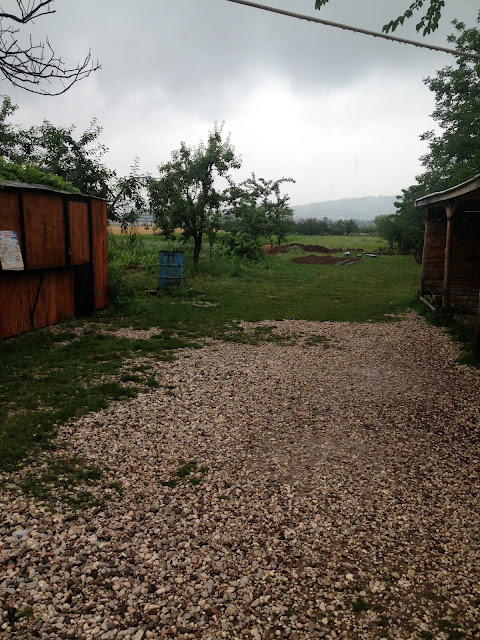 |
| As you can see in the picture above, the Bosnian Serbs controlled the hills around Sarajevo. They rained explosives onto the town. Sometimes, they went unexploded. |
 |
| Here Brian is looking at the memorial to a massacre by explosive that occurred at this market. Some 60 innocent residents died, just trying to do some market shopping. |
 |
 |
| A building the faced towards Grbavica. Still bears the holes of the bullets it absorbed. |
 |
| This is one of the few streets that has mature trees in Sarajevo? Why was it not cut down for firewood during the siege? |
 |
| Because just on the other side of the river, Bosnian Serbs held these apartment buildings. No one was willing to get shot at from such close range. |
 |
| So if the residents of Sarajevo were cut off from supplies, how did they get any food? The answer lies below this house out west by the airport. |
 |
| The residents dug a secret tunnel to shuttle people and food in and out. It literally ran underneath the airport. |
 |
| Out in this nondescript backyard was the lifeline of the residents under siege. |













1 comment:
Actually you can see in that map that the Bosnian Muslims did control a lot of mountainous and high-ground areas. Also the territory that they control goes north off the map so they aren't surrounded up there.
You also leave out that the UN had soldiers/personnel stationed and living in Sarajevo throughout the entire war and they regularly got fuel and food deliveries and also regularly came and departed by the airport.
The airport was handed to the UN by the Bosnian Serbs near the beginning of the war.
As for that tunnel feeding the people - that is untrue. The tunnel was controlled by the military and was for fighters and weapons.
Food and fuel came regularly by convoys/trucks into Sarajevo during the "siege". They even ran through Serbian territory of course, but this wasn't mentioned unless they were held-up or delayed - and this because weapons or fighters were found in them.
The Bosnian Muslims did use buildings in Sniper's Alley - this was testified by UN personnel who witnessed this. French Marines also traced sniper fire to the Bosnian Muslims using the former Parliamentary building.
The Bosnian Muslims had the largest number of forces in Sarajevo by far and also in Bosnia. They were receiving heavy weapons deliveries despite the embargo and the west knew about it and admitted it after the war.
There were especially huge deliveries coming through Croatia. Slovenia was profiting by deliveries of these weapons from all over then transporting them to Croatia.
Also Croatian was getting deliveries of Iranian arms for the Bosnian Muslims and skimming off some for themselves.
Long before the war's end the Bosnian Muslims had amassed huge weapons supplies and their army was much better equipped than the beginning of the war.
But from the beginning they held areas with arms factories and had earlier shipments of weapons by Mr. Cengic.
Sarajevo Serb civilians caught on the Muslim-held side were sent to many concentration camps and beaten to death. Serbs claim almost 7,000 Sarajevo Serb civilians were liquidated by Bosniak paramilitary, military and police during the war.
Sarajevo is now almost pure Muslim "Bosniak". Prewar it had almost 40% Serbs - they are all gone. It was an ethnic cleaning and genocide of its Serbian residents from the start.
Read about Musan Topalovic, Jusuf Prazina, "Celo", "Caco" and many other Bosniak warlords who were murdering Serbs from the start.
Also read out the grain silo concentration camp the Serbs were held in Tarcin.
Currently there's digging at a Sarajevo landfill in which they've found human remains buried 27 meters under the debris. These are believed to by some of the Sarajevo Serb civilians murdered by Bosniaks.
Post a Comment